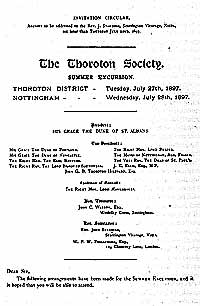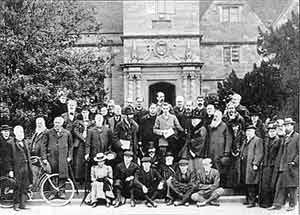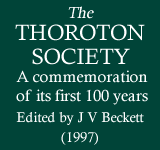iv. The Thoroton Society[17]
The key figures responsible for the setting up of the Thoroton Society in 1897 were Lord Hawkesbury and W.P.W. Phillimore. Hawkesbury, a member of the Foljambe family of Osberton Hall, was M.P. for North Nottinghamshire and for Mansfield prior to his ennoblement in 1893. He was raised to the earldom of Liverpool in 1906, and was Lord Steward in King Edward VII’s household. Phillimore, born William Phillimore Watts Stiff, was the son of Dr Stiff, a Nottingham doctor, but he later took the name Phillimore from the family of his maternal grandmother. An Oxford-educated solicitor, he had already founded a British and a Scottish Record Society and the Canterbury and York Society before turning his attention to his native county. One of his life’s interests, and the achievement for which he is best remembered, was the transcription and printing of marriage registers. When he died in 1914, he had covered 1200 parishes from many counties in 200 volumes. Phillimore was, in more senses than one, a character: he has been described as ‘a cadaverous figure, six feet of skin and bone with long hair, a long forked beard and heavy-lidded myopic eyes: a strict vegetarian and teetotaller’. A cartoon dating from 1900 certainly confirms this description.
Hawkesbury and Phillimore put forward a series of proposals in January 1897 for setting up a county society which they proposed to call The Thoroton Society. In March 1897 the proposals were formalized into a circular letter, and in May a notice was sent out convening the founding meeting at the Shire Hall on 1 June 1897. Fifty people attended the meeting, but eighty-nine had already promised to join the fledgling society, and this total rose to 234 within three months of the launch and to 263 within seven months.’[18] The inaugural meeting, which is detailed in volume 1 of Transactions, saw the Society launched with a constitution and an infrastructure. The Duke of St Albans became the President, with no fewer than nine elected vice presidents: two dukes (Portland and Newcastle), Earl Manvers, the Bishop of Southwell, the Dean of St Pauls (a Nottingham man), the Mayor of Nottingham, Lord Belper, John Ellis M.P., and John Thoroton Hildyard, who was great-great-uncle to the present President Myles Thoroton Hildyard. A council of twelve members was elected, with a chairman –Lord Hawkesbury –who never attended another meeting! In his place the chair was usually taken by the Rev A.J.L. Dobbin, Vicar of Cropwell Bishop. His grandson, the late Michael Dobbin, was a member of Council and, for some years in the 1970s, the Society’s honorary secretary. In 1897 the two honorary secretaries were W.P.W. Phillimore and the Rev. John Standish, Vicar of Scarrington and Aslockton. John Crosby Warren, a solicitor, was elected as the honorary treasurer, a position he held for twenty-four years. The initial subscription was 10s 6d, with associates and ladies paying 5s, and gentlemen 7s 6d.
 |
Circular advertising the inaugural summer excursion, 1897. |
The inaugural meeting was followed in July by the first excursions, which took place by courtesy of the train service from Nottingham, and horse-drawn brakes. The early members believed in a hard day of excursioning! On Tuesday 27 July fifty members met at Bingham Station and proceeded in the brakes to localities connected with Dr Thoroton in the villages of Car Colston, Screveton, Hawksworth and Thoroton. On leaving the Hall at Thoroton the lead horse of the second three-horse brake became restless, turned around and caused the other horses to rear up. One of them got its legs over the bar, and the brake had practically to be dismantled to set it free. Undaunted, the party moved on to Aslockton, some of the members on foot, while the brake was repaired. Lunch was taken at the Griffin in Whatton-in-the-Vale, and the party then travelled to Langar, to Wiverton (where they were received by Mrs Chaworth-Musters), and to Bingham for tea. On the following day, 28 July, members assembled at St Mary’s Church, Nottingham, and then moved on to St Peter’s and to the Castle, where they saw medieval remains, and had lunch in the refreshment room. In the afternoon they went to Wollaton. The day was rounded off with a dinner at the Albert Hall, at which William Stevenson read a paper on ‘The Early Churches of Nottinghamshire’, and Phillimore completed the proceedings with a paper on ‘The Work We Have to do’ .[19]
Phillimore had conceived of the Society as a working group in which members would play an active role, but for the most part his hopes were not immediately fulfilled. In his 1897 paper he proposed studies of the county’s archaeology, history, dialects, and parish churches, and the recording of monumental inscriptions together with the compilation of a photographic record. He circulated the membership proposing a working party, but only eighteen replied! Even so, the first volume of Transactions included reports of the meetings and excursions in the inaugural year, as well as information on work being done on parish registers, an index of recently published archaeological papers, and the Rules of the Society. Phillimore’s own work was sufficiently pressing that in 1900 he resigned the joint secretaryship, and was succeeded by George Fellows, of the banking family, who lived in Beeston Fields and was a most methodical and industrious secretary. Fellows held the office for nineteen years.
 |
Excursion to Rufford, 1898. The figure on the extreme left (in the hat) is Cornelius Brown, historian of Newark; next to him is Colonel Mellish of Hodsock, and the fourth figure from the left (above the bicycle wheel) is Robert Mellors, the noted Nottingham antiquarian. The bearded figure near the centre is W.P.W. Phillimore, and on his left (wearing a clerical collar) is the Rev. John Standish. The young man with a coat on his arm in the centre of the picture is T.M. Blagg. The man on the back row with a black moustache is the Rev. R. Jowett Burton of the wheel accident (see text). Other figures are identified in Transactions. L (1946), 21. |
In 1898 the Society paid its first visit to the north of the county. Alighting at Mansfield, the members were taken in five large brakes to Edwinstowe for lunch. They were then squeezed into the Major Oak, twelve at a time, before moving on to Rufford, the site of the first Society photograph. The programme on this occasion proved too ambitious. Visits to Mansfield and Mansfield Woodhouse churches had to be abandoned, and the party was able to visit only Warsop before it was time for tea and the journey home. The timing of excursions was always difficult in the early years, partly because of travel arrangements but also because long-winded speakers occasionally talked for longer than anticipated! The 1898 Annual General Meeting was held in the Assembly Rooms at Southwell, and the Duke of Portland was elected President in succession to the Duke of St Albans, who had died in May 1898.
The highlight of 1899 was the two-day Exhibition and ‘Conversazione’ held in the Nottingham Exchange Building, where the Duke and Duchess of Portland received members on the first evening. Four hundred exhibits, floral decorations, refreshments, a band and glee quartet all made for a memorable two days. This exhibition must surely have been the most comprehensive collection of ‘antiquities and historical objects etc.’ ever brought together under one roof in Nottingham. The section headings included coins, tokens, medals, books, art bookbindings, manuscripts, letters, bookplates, seals, newspapers, paintings, views, maps and photographs, lace and embroideries, silver and pewter, bronzes and brasses, and pottery. Organizations such as the Nottingham Mechanics Institute, Bromley House Library, and the Nottingham Free Public Library loaned some of their most precious books and manuscripts, the Mayor and Corporation loaned ancient charters and the Mayor’s and Sheriffs’ maces. Individuals were equally co-operative, especially the Rev. R. Baron von Hube, Mr James Ward and Mr J.T. Spalding, who loaned exhibit 298 – ‘Tea Pot, silver, in form of a camel. The panniers hold tea and milk respectively. By turning the handle at the bottom the camel bends its neck, and by pressing either of the two knobs at the back of the driver, the tea, or milk, pours out of its mouth. The inverted basin, and the spoon, are intended for sugar. Indian.’ Unfortunately the Duke of Portland seems to have been less happy with the event since he is not known to have attended any other meeting during his forty-five years as President! He did, however, open Welbeck Abbey to members and, on a dry, dusty day, the column of Thoroton Society members could be seen coming from afar, like a biblical pillar of cloud. Brakes continued to be used until the first char-a-banc excursion in 1914.
One of the excursions in 1900 was to Newark and its surroundings, and a tongue-in-cheek and beautifully illustrated account appeared in a little-known, hand produced magazine called The Wilford Sketch, with some brilliant cartoons. It makes fascinating reading, particularly when compared with the ‘official’ account written up for the following year’s Transactions. Accidents of one sort or another seem to have been frequent on early excursions. T.M. Blagg, writing of the Society’s early years describes one with a happy outcome:- ‘on one of these expeditions a hind wheel of one vehicle collapsed and the Rev. R. Jowett Burton of Darley Abbey and Miss Browne, daughter of Mr Hugh Browne of Aspley, who were on the back seat, were shot on to the road in a heap. Their flirtation had already attracted much interest, and as they married shortly afterwards everyone said it was the mix-up on the roadway which clinched the courtship.’[20]
